Why is SEMrush Considered a Top Choice for Paid Keyword Research?
SEMrush is a powerful suite of tools used by digital marketers worldwide to streamline their workflows and optimize their campaigns. From SEO to PPC and content marketing, SEMrush offers a range of features that help businesses improve their online visibility and overall digital performance.
Below is an in-depth exploration of the most notable SEMrush features, providing insights and practical examples to help you make the most of this tool.
1. Keyword Research: Finding the Right Keywords for Your Campaigns
Overview: SEMrush’s Keyword Research tool helps users identify the best keywords to target based on factors like search volume, competition, and keyword difficulty.
Why It’s Important: Choosing the right keywords is essential for driving traffic to your website. It ensures that your content is discoverable by users searching for topics related to your products or services.
Practical Example: A blogger writing about fitness may use SEMrush to find keywords such as “best home workout routines” or “fitness tips for beginners,” then use this data to and create content that is strategically designed to perform well in search engine rankings.
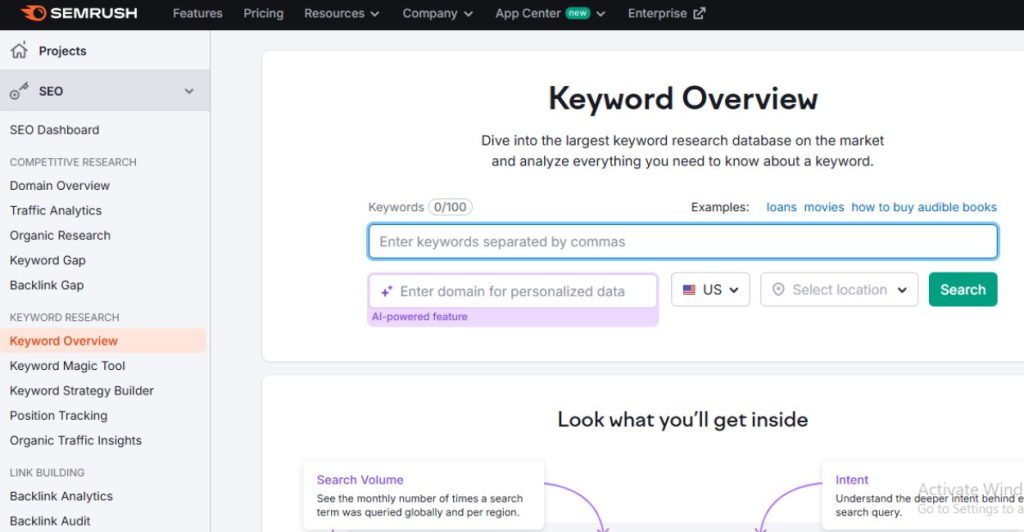
2. Website Audit: Tracking and Enhancing Site Performance
Overview: The Site Audit tool scans your website for common SEO issues like broken links, slow loading times, and duplicate content, then provides actionable suggestions for improvements.
Why It’s Important: Regular site audits help ensure your website is optimized for search engines and provides a better user experience, which can contribute to higher rankings and reduced bounce rates.
Practical Example: If your website has slow page load times, SEMrush can help you identify specific areas for improvement. For example, if SEMrush detects large, unoptimized images on your site, it will recommend compressing or resizing them to reduce file size without sacrificing quality. This can greatly enhance your site’s loading speed.
Let’s say you have an image on your homepage that’s 2MB in size, which could take several seconds to load on slower connections. SEMrush will flag this as an issue in its site audit report, and it will suggest using formats like WebP or tools like ImageOptim or TinyPNG to compress the image. By following this advice, you could reduce the image size to just 200KB, leading to a much faster page load time.
Additionally, SEMrush might identify inefficient coding practices, such as render-blocking JavaScript or CSS files, that delay the page from displaying content to users. In such cases, SEMrush could recommend code minification or the use of asynchronous loading for JavaScript, which allows the browser to load the content faster.
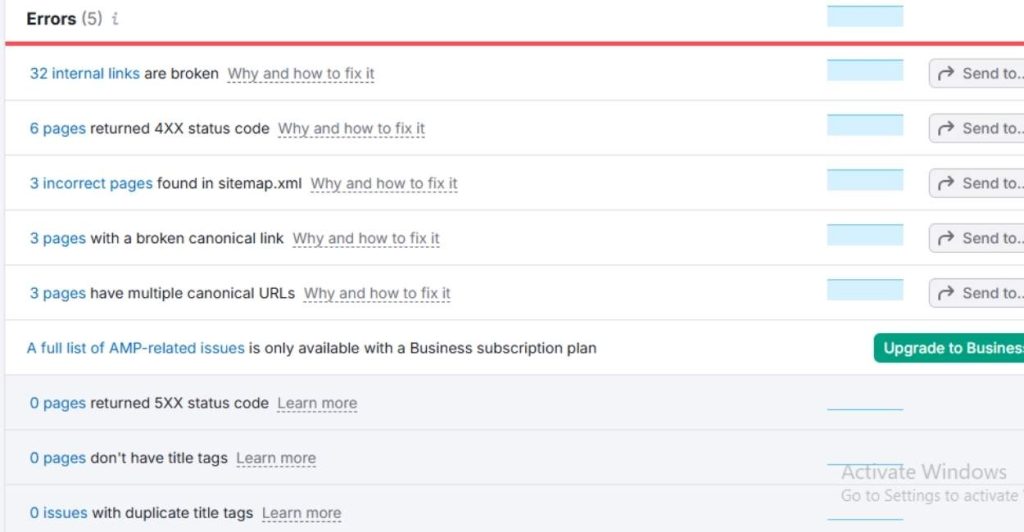
3. Backlink Analysis: Understanding and Managing Your Link Profile
Overview: Backlinks are a major ranking factor for Google. SEMrush’s Backlink Analytics tool provides insights into the number and quality of backlinks pointing to your site, as well as your competitors’ sites.
Why It’s Important: Knowing the quality and quantity of backlinks helps you understand your domain authority and reveals opportunities for new link-building strategies.
Practical Example: If a competitor has backlinks from high-authority websites in your industry, you might target similar websites for link-building opportunities, improving your own authority and rankings.
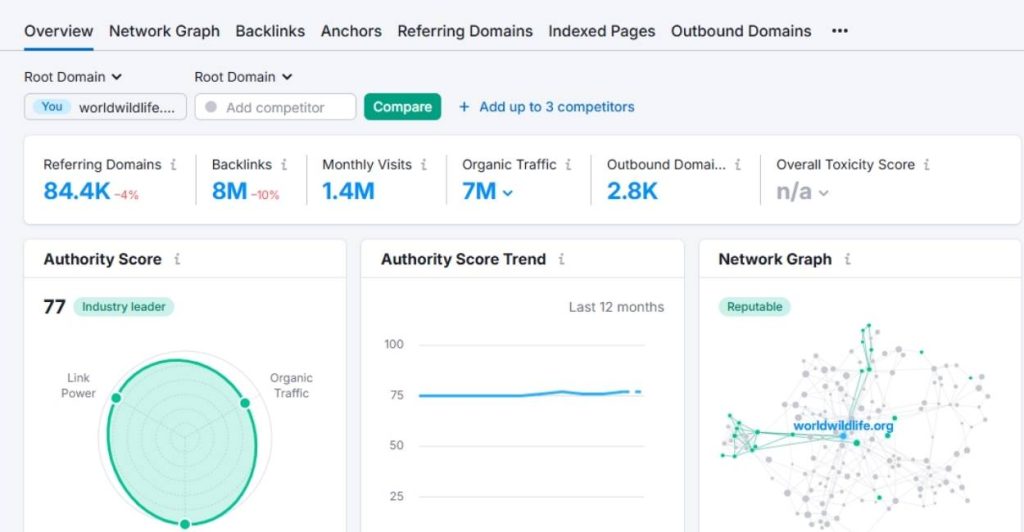
4. Position Tracking: Monitoring Your Keyword Rankings
Overview: The Position Tracking tool allows you to track your rankings for specific keywords over time, with a detailed breakdown by device, location, and search engine.
Why It’s Important: Tracking keyword rankings enables you to assess the effectiveness of your SEO strategies and adjust your approach as needed.
Practical Example: If you’re tracking the keyword “digital marketing tips” and notice a drop in rankings, SEMrush can help you identify the cause and suggest strategies to recover your position, such as optimizing your content or building additional backlinks.
5. Competitor Analysis: Understanding Your Competitors’ Strategies
Overview: SEMrush allows you to analyze your competitors’ organic and paid search strategies, helping you understand where they’re succeeding and identify opportunities to outperform them.
Why It’s Important: Knowing your competitors’ strategies helps you refine your own approach, whether that’s by improving content quality, targeting different keywords, or increasing your advertising budget.
Practical Example: If you’re running a travel agency and notice that your competitors are ranking well for specific long-tail keywords like “best vacation packages for families,” you might target similar keywords and create better content.
6. Content Analyzer: Optimizing Your Content for SEO
Overview: SEMrush’s Content Analyzer helps assess the performance of your content, offering suggestions to improve SEO. It evaluates metrics like readability, keyword usage, and overall structure.
Why It’s Important: Optimizing your content ensures that it is well-structured, easy to read, and ranks for the right keywords.
Practical Example: If you’re writing a blog post on “healthy eating habits” and the tool recommends using semantically related keywords such as “balanced diet” or “nutritional tips,” incorporating these terms can strengthen your content and boost your chances of ranking higher.
7. Link Building: Managing Your Outreach and Building Quality Links
Overview: SEMrush’s Link Building tool helps identify backlink opportunities, manage outreach campaigns, and track the progress of your link-building efforts.
Why It’s Important: Backlinks are a key factor in SEO success, and managing link-building efforts efficiently ensures you get quality links that improve your domain authority.
Practical Example: If you’re a tech blog owner, you could use SEMrush to identify high-authority websites in the tech niche that accept guest posts. By acquiring backlinks, you enhance your site’s authority and boost its search engine rankings.
8. Traffic Analytics: Gaining Insights into Competitor Traffic
Overview: SEMrush’s Traffic Analytics tool lets you analyze the traffic of competitors’ websites, revealing their most popular pages and traffic sources (organic, paid, social, etc.).
Why It’s Important: Understanding where competitors are getting their traffic allows you to identify untapped opportunities and create a more competitive marketing strategy.
Practical Example: If you notice that your competitor is getting a lot of social traffic, you might focus on social media campaigns to drive similar engagement. So SEMrush is a good tool for SEO success.

9. Social Media Tracker: Monitoring Social Media Performance
Overview: This tool tracks social media mentions, engagement, and performance across various platforms. It helps you understand how well your social media campaigns are performing.
Why It’s Important: Social media presence can significantly impact brand visibility, and this tool ensures your social media strategy is driving traffic and engagement.
Practical Example: If you run a brand and notice that one particular post about a product launch is getting significantly more engagement than others, SEMrush can provide insights into why, allowing you to replicate successful strategies.
10. Google Ads Research: Analyzing Paid Advertising Campaigns
Overview: SEMrush’s Google Ads Research tool provides detailed information about the ad strategies of your competitors, including ad copy, keywords, and budgets.
Why It’s Important: By analyzing competitors’ paid campaigns, you can uncover opportunities to optimize your own PPC strategies.
Practical Example: If you’re advertising a new service and see that competitors are targeting similar keywords but using different ad copy, you can tweak your ads to stand out and increase your ad click-through rate.
11. Keyword Magic Tool: Uncovering Keyword Variations
Overview: SEMrush’s Keyword Magic Tool is designed to uncover keyword variations and long-tail keywords that you can target to optimize your content and ads.
Why It’s Important: Long-tail keywords are often less competitive and can drive highly targeted traffic to your site.
Practical Example: If you’re optimizing for the keyword “digital marketing,” the Keyword Magic Tool may suggest additional terms like “affordable digital marketing services” or “digital marketing for small businesses” that you could target.
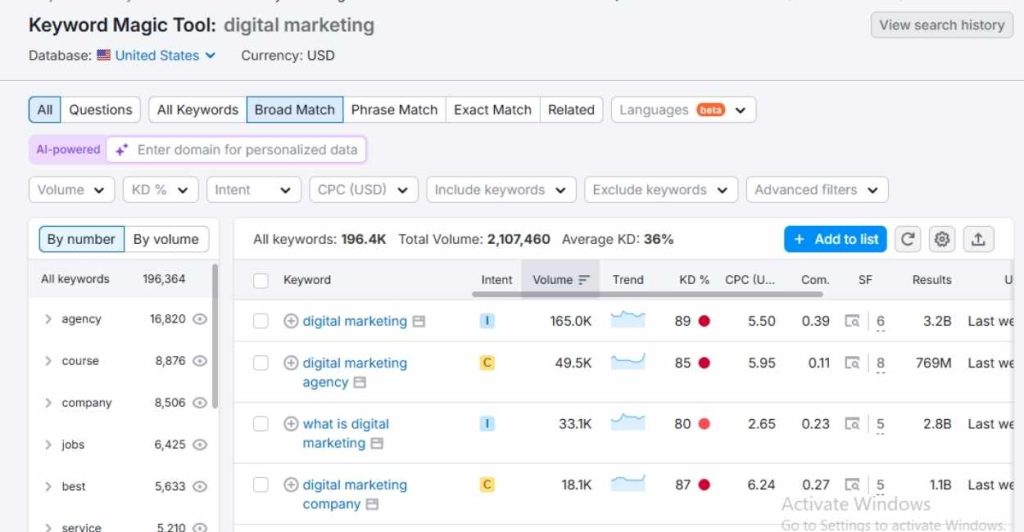
12. Market Explorer: Analyzing Industry Trends
Overview: The Market Explorer tool helps you understand the broader market landscape by analyzing trends, major players, and growth opportunities.
Why It’s Important: Understanding the market landscape allows you to identify new growth areas and stay ahead of competitors.
Practical Example: If you run a SaaS business and the Market Explorer reveals a growing trend for remote collaboration tools, you could pivot your marketing efforts to target this emerging niche.
13. SEO Writing Assistant: Optimizing Content for Search Engines
Overview: The SEO Writing Assistant helps optimize your content by analyzing it against top-ranking pages for specific keywords, providing suggestions to improve keyword usage, readability, and structure.
Why It’s Important: Writing optimized content improves your chances of ranking higher in search engines, driving more organic traffic.
Practical Example: If you’re writing a blog post on “best online courses for digital marketing” and the tool suggests including more subheadings and internal links, following these recommendations can make your content more SEO-friendly.
14. Rank Tracking: Keeping Track of Your Search Performance
Overview: The Rank Tracking tool lets you track your rankings over time, compare your performance to competitors, and identify areas for improvement.
Why It’s Important: Consistent tracking ensures your SEO efforts are paying off and allows you to adjust strategies if rankings start to drop.
Practical Example: If you notice that your ranking for a high-converting keyword is slipping, SEMrush can alert you to this drop, prompting you to revisit your content or backlink strategy.
| Feature | Description |
|---|---|
| Market Explorer | Analyzes industry trends, major players, and growth opportunities to help businesses understand the market landscape. |
| SEO Writing Assistant | Provides optimization suggestions based on top-ranking pages to improve keyword usage, readability, and structure. |
| Rank Tracking | Monitors search rankings over time, compares performance with competitors, and identifies improvement areas. |
15. Content Marketing Platform: Creating and Distributing Content
Overview: SEMrush’s Content Marketing Platform provides tools for creating, publishing, and distributing content across different platforms. It integrates with your existing workflows and helps you measure content performance.
Why It’s Important: A solid content marketing strategy can help increase organic traffic, engage users, and convert leads.
Practical Example: If you have a blog and want to repurpose your best-performing articles into social media posts, SEMrush can help you streamline content creation and track its performance.
16. SEO Dashboard: Centralizing Your SEO Insights
Overview: The SEO Dashboard aggregates all your SEO data in one place, including rankings, site health, backlinks, and more, for easy monitoring and decision-making.
Why It’s Important: Having all SEO metrics in one place helps you make informed decisions faster and more effectively.
Practical Example: If you’re working on multiple client projects, the SEO Dashboard allows you to compare and monitor SEO performance across all your sites without switching between different tools.
17. Lead Generation Tool: Collecting Qualified Leads
Overview: The Lead Generation tool helps you find potential clients and customers by capturing leads through forms and offering insights into their behavior.
Why It’s Important: Lead generation is essential for growing your business, and SEMrush makes it easy to capture and track high-quality leads.
Practical Example: If you run a marketing agency, the tool can help you identify businesses that are actively searching for SEO services, allowing you to reach out to them with tailored offers.
18. PPC Keyword Tool: Optimizing Your Paid Search Campaigns
Overview: This tool helps optimize your paid search campaigns by identifying profitable keywords and managing your PPC strategies more effectively.
Why It’s Important: Managing PPC campaigns effectively ensures you get the best ROI on your advertising spend.
Practical Example: If you’re running a paid campaign for “e-commerce development,” the PPC Keyword Tool can help you find negative keywords to exclude from your campaigns and identify more cost-effective keywords to target.
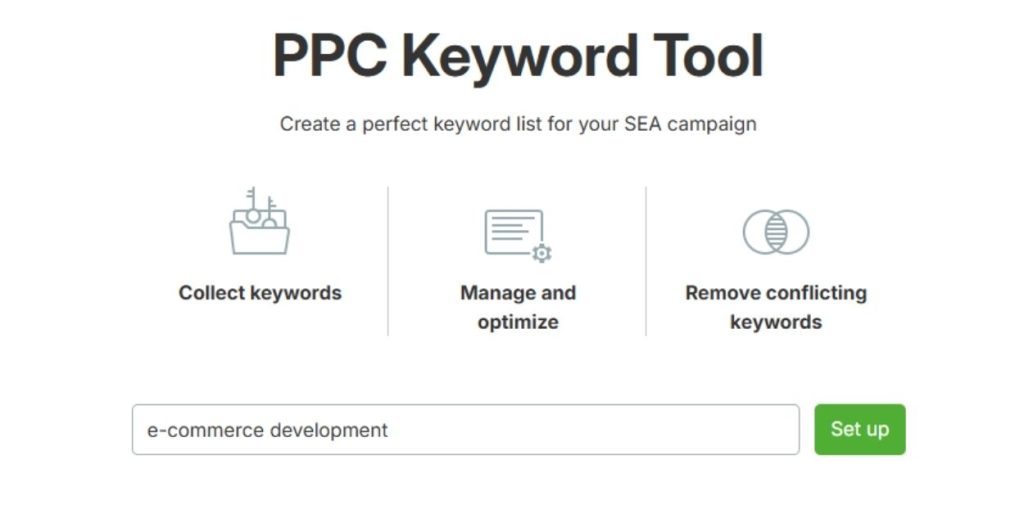
19. Content Ideas: Generating Ideas for New Content
Overview: SEMrush’s Content Ideas feature helps you find content gaps and generate ideas based on trending topics, search volume, and competition.
Why It’s Important: Fresh and engaging content keeps users coming back and can help your website rank better over time.
Practical Example: If you’re in the fashion industry and want to create content around “seasonal trends,” SEMrush can help you uncover emerging topics related to fashion trends, providing new content ideas to explore.
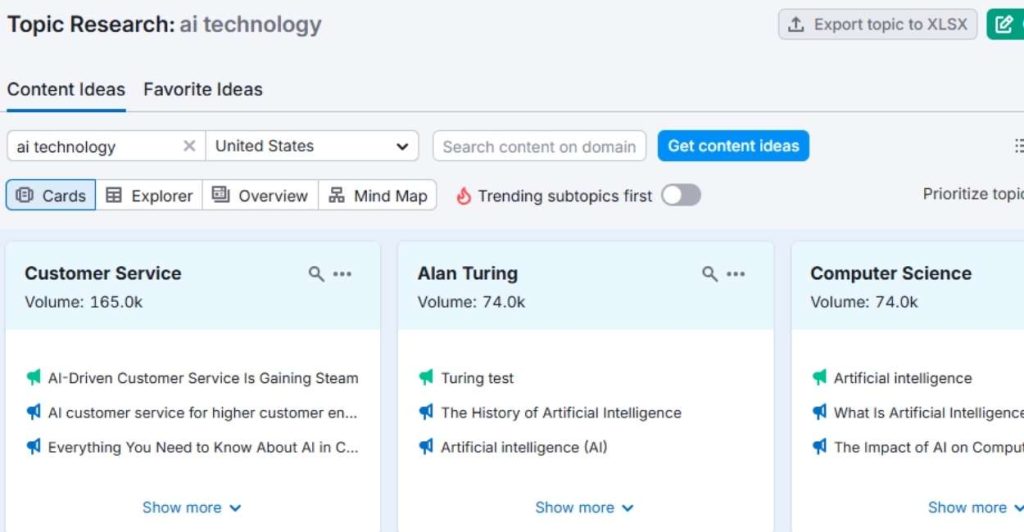
20. Topic Research: Uncovering Relevant Topics to Write About
Overview: Topic Research gives you insight into popular topics within your niche, as well as content ideas that are performing well.
Why It’s Important: Creating content around high-demand topics ensures you stay relevant and attract organic traffic.
Practical Example: If you’re managing a blog about AI technology, SEMrush can provide data on trending topics like “AI in healthcare” or “AI tools for marketing,” giving you ideas to write in-demand articles.
21. Brand Monitoring: Tracking Your Online Reputation
Overview: Brand Monitoring allows you to track mentions of your brand across the web, social media, and news outlets.
Why It’s Important: Maintaining a positive online reputation is crucial for businesses today, and being able to monitor your brand’s mentions ensures you can respond quickly to negative feedback or capitalize on positive mentions.
Practical Example: If a popular influencer mentions your brand, SEMrush will alert you to this mention, allowing you to engage with the influencer and increase brand visibility.
22. Social Media Poster: Scheduling and Publishing Posts
Overview: The Social Media Poster allows you to schedule and publish social media posts from one centralized location.
Why It’s Important: Consistency is key in social media marketing, and this tool helps ensure your posts go live at optimal times to reach your audience.
Practical Example: If you’re managing social media for a product launch, you can schedule posts across various platforms in advance, ensuring maximum visibility at the right time.
23. Market Research: Analyzing Your Market’s Growth and Trends
Overview: This tool helps you analyze the growth and trends in your specific market by providing data on search volume, competition, and emerging trends.
Why It’s Important: Staying informed about your market ensures you can adjust your marketing strategy to capitalize on growth opportunities.
Practical Example: If you’re running a B2B SaaS business and SEMrush shows a growing interest in AI-driven automation tools, you might pivot your marketing focus to highlight AI-powered features in your product.
24. Local SEO: Optimizing for Local Search Results
Overview: SEMrush offers tools to optimize your website for local searches, including managing business listings and local citations.
Why It’s Important: Local SEO helps businesses attract customers from their geographic area, ensuring visibility in local search results.
Practical Example: A restaurant could use Local SEO tools to ensure it appears in Google’s local search results for terms like “best pizza near me,” driving more foot traffic to their location.
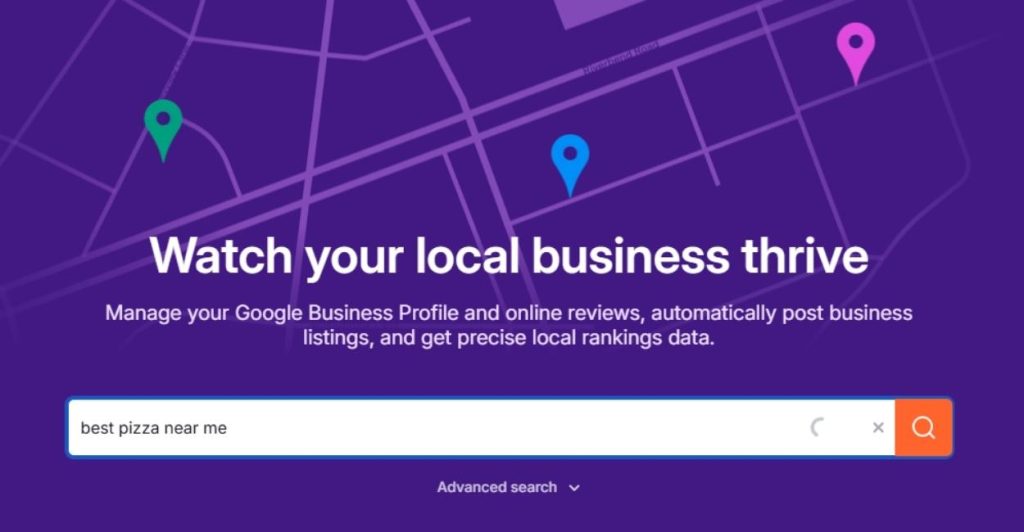
25. SEO Forecast: Predicting Future Traffic and Performance
Overview: SEMrush’s SEO Forecast tool helps predict future traffic based on historical data, giving you a clear picture of how your SEO strategy might perform.
Why It’s Important: Forecasting your SEO results allows you to plan for future growth and set realistic expectations.
Practical Example: If your SEO campaign is predicted to drive 20% more traffic in the next quarter, you can allocate more resources to further optimization or expansion efforts.
FAQ: SEMrush Features
1. What is SEMrush used for?
SEMrush is an all-in-one digital marketing tool that helps businesses improve their online visibility and performance. It provides a suite of tools for keyword research, SEO audits, backlink analysis, competitor research, content marketing, paid advertising (PPC), social media tracking, and more. It is used for optimizing websites, managing PPC campaigns, analyzing competitors, and creating better content strategies.
2. How does SEMrush help with SEO?
SEMrush helps with SEO by providing tools for keyword research, site audits, backlink analysis, rank tracking, and competitor analysis. It helps you discover high-value keywords, find SEO errors, build quality backlinks, track your rankings over time, and optimize content to improve your site’s visibility in search engine results.
3. Can SEMrush be used for paid advertising (PPC)?
Yes, SEMrush has several tools specifically for managing and optimizing paid advertising campaigns. It offers insights into your competitors’ Google Ads strategies, helps you discover profitable PPC keywords, and allows you to track your paid campaigns’ performance.
4. What is the Keyword Magic Tool in SEMrush?
The Keyword Magic Tool is a feature within SEMrush that helps you uncover a wide range of related keywords to target for your SEO or PPC campaigns. It provides keyword suggestions, search volume data, and competition level for each keyword, helping you discover long-tail keywords and more targeted opportunities.
5. How often should I run a Site Audit on SEMrush?
It is recommended to run a Site Audit regularly, at least once a month, to monitor your website’s health. Regular audits help identify and fix SEO issues, such as broken links, slow loading speeds, or duplicate content, which can negatively impact your site’s performance and rankings.
6. What are backlinks, and why are they important?
Backlinks are links from external websites that direct traffic to your site. They play a crucial role in boosting your site’s authority and credibility. The more high-quality backlinks you acquire, the greater your potential to rank higher in search engine results.
7. Can SEMrush help with social media marketing?
Yes, SEMrush offers several features to track and manage your social media presence. With tools for social media monitoring, posting, and performance analysis, SEMrush helps you track mentions of your brand, engage with your audience, and measure the success of your social campaigns.
8. Is SEMrush suitable for beginners?
Yes, SEMrush is suitable for beginners. It offers user-friendly interfaces and provides tutorials and support resources to help newcomers get started. While some of its features can be more advanced, beginners can easily navigate the basic tools for keyword research, site audits, and tracking.
9. How does SEMrush’s Competitor Analysis tool work?
SEMrush’s Competitor Analysis tool allows you to enter your competitors’ domains and analyze their traffic, keyword rankings, backlinks, and paid advertising strategies. This helps you identify their strengths and weaknesses and develop strategies to outperform them in search engine results.
10. Can SEMrush track local SEO performance?
Yes, SEMrush offers features for local SEO, including local keyword tracking, managing business listings, and ensuring your website is optimized for local search results.
11. How can SEMrush help improve my content marketing strategy?
SEMrush helps you develop a content marketing strategy by providing content research tools, optimizing existing content for SEO, generating topic ideas, and tracking content performance. The tools suggest trending topics and keywords and offer content performance metrics, helping you create content that resonates with your target audience.
12. How accurate is SEMrush’s keyword data?
SEMrush’s keyword data is quite accurate and relies on its extensive database of search engine results and competitors’ keyword data. However, the accuracy may vary slightly based on your location, the frequency of updates, and search engine fluctuations. It’s always a good idea to cross-check SEMrush data with other tools to get a well-rounded view.
13. What kind of reports can I generate with SEMrush?
SEMrush allows you to generate a variety of reports, including keyword rankings, site audit reports, backlink analysis, competitor insights, and social media performance. These reports are customizable and can be scheduled to send to your inbox regularly.
14. Does SEMrush offer customer support?
Yes, SEMrush offers customer support through various channels, including live chat, email, and a comprehensive help center with guides, tutorials, and FAQs. They also provide webinars and live workshops to help users learn how to use the platform effectively.
15. Can I use SEMrush for international SEO?
Yes, SEMrush supports international SEO efforts. It offers features like location-based keyword tracking, language-specific search engine analysis, and country-specific competitors’ data. This makes it easy for businesses to optimize their websites for different markets around the world.
16. How does SEMrush compare to other SEO tools like Ahrefs and Moz?
SEMrush is often compared to Ahrefs and Moz due to its similar feature sets. SEMrush is more comprehensive in terms of paid advertising, social media tools, and competitive research, whereas Ahrefs tends to excel in backlink analysis and site audits. Moz is often favored for local SEO and its beginner-friendly interface.
17. Is SEMrush worth the investment for small businesses?
Yes, SEMrush is a valuable investment for small businesses, as it helps improve online visibility, drive traffic, and optimize marketing efforts. While the cost may seem steep for small businesses, the ROI from improved SEO and PPC performance can be significant.